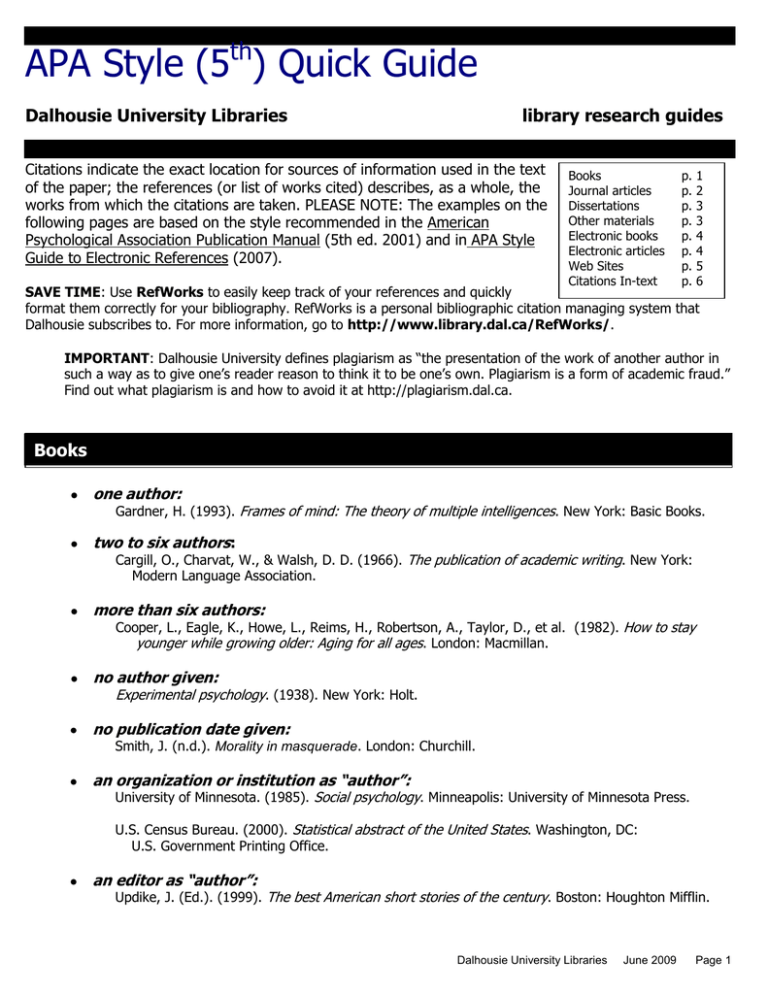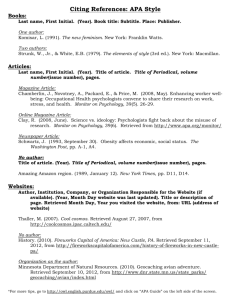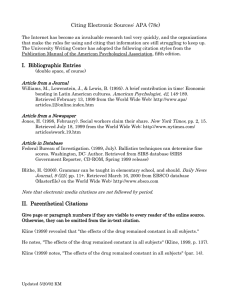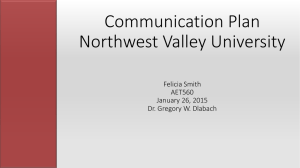APA Style (5 ) Quick Guide - Libraries
advertisement

th APA Style (5 ) Quick Guide Dalhousie University Libraries library research guides Citations indicate the exact location for sources of information used in the text of the paper; the references (or list of works cited) describes, as a whole, the works from which the citations are taken. PLEASE NOTE: The examples on the following pages are based on the style recommended in the American Psychological Association Publication Manual (5th ed. 2001) and in APA Style Guide to Electronic References (2007). Books Journal articles Dissertations Other materials Electronic books Electronic articles Web Sites Citations In-text p. p. p. p. p. p. p. p. 1 2 3 3 4 4 5 6 SAVE TIME: Use RefWorks to easily keep track of your references and quickly format them correctly for your bibliography. RefWorks is a personal bibliographic citation managing system that Dalhousie subscribes to. For more information, go to http://www.library.dal.ca/RefWorks/. IMPORTANT: Dalhousie University defines plagiarism as “the presentation of the work of another author in such a way as to give one’s reader reason to think it to be one’s own. Plagiarism is a form of academic fraud.” Find out what plagiarism is and how to avoid it at http://plagiarism.dal.ca. REFERENCES Books one author: Gardner, H. (1993). Frames of mind: The theory of multiple intelligences. New York: Basic Books. two to six authors: Cargill, O., Charvat, W., & Walsh, D. D. (1966). The publication of academic writing. New York: Modern Language Association. more than six authors: Cooper, L., Eagle, K., Howe, L., Reims, H., Robertson, A., Taylor, D., et al. (1982). How to stay younger while growing older: Aging for all ages. London: Macmillan. no author given: Experimental psychology. (1938). New York: Holt. no publication date given: Smith, J. (n.d.). Morality in masquerade. London: Churchill. an organization or institution as “author”: University of Minnesota. (1985). Social psychology. Minneapolis: University of Minnesota Press. U.S. Census Bureau. (2000). Statistical abstract of the United States. Washington, DC: U.S. Government Printing Office. an editor as “author”: Updike, J. (Ed.). (1999). The best American short stories of the century. Boston: Houghton Mifflin. Dalhousie University Libraries June 2009 Page 1 an edition of an author’s work: Brockett, O. (1987). History of the theatre (5th ed.). Boston: Allyn and Bacon. a translation: Freud, S. (1970). An outline of psychoanalysis (J. Strachey, Trans.). New York: Norton. (Original work published 1940) a work in a series: Cousins, M. (1984). Michel Foucault. Theoretical traditions in the social sciences. New York: St. Martin's Press. a work in several volumes: Wilson, J. G., & Fraser, F. C. (Eds.). (1977-1978). Handbook of teratology (Vols. 1-4). New York: Plenum Press. conference proceedings: Schnase, J. L., & Cunnius, E. L. (Eds.). (1995). Proceedings of CSCL '95: The First International Conference on Computer Support for Collaborative Learning. Mahwah, NJ: Erlbaum. chapter in an edited book: Rubenstein, J.P. (1967). The effect of television violence on small children. In B. F. Kane (Ed.), Television and juvenile psychological development (pp. 112-134). New York: American Psychological Society. Articles journal / periodical (continuous pagination): Brabant, S., & Mooney, L. A. (1997). Sex role stereotyping in the Sunday comics: A twenty year update. Sex Roles, 37, 269-281. journal / periodical (non-continuous pagination): Sawyer, J. (1966). Measurement and prediction, clinical and statistical. Psychological Bulletin, 66 (3), 178-200. journal article with three to six authors: Tolin, D. F., Abramowitz, J. S., Brigidi, B. D., Amir, N., Street, G. P., & Foa, E. B. (2001). Memory and memory confidence in obsessive-compulsive disorder. Behaviour Research & Therapy, 39, 913-927. journal article with seven or more authors: Mariani-Costantini, R., Ottini, L., Caramiello, S., Palmirotta, R., Mallegni, F., Rossi, L., et al. (2001). Taphonomy of the fossil hominid bones from the Acheulean site of Castel di Guido near Rome, Italy. Journal of Human Evolution, 41, 211-225. newspaper: Monson, M. (1993, September 16). Urbana firm obstacle to office project. The Champaign-Urbana News-Gazette, pp. 1, 8. magazine: Raloff, J. (2001, May 12). Lead therapy won't help most kids. Science News, 159, 292. Dalhousie University Libraries June 2009 Page 2 review: Gleick, E. (2000, December 14). The burdens of genius [Review of the book The last samurai]. Time, 156, 171. article in a reference book or encyclopedia - signed and unsigned : Sturgeon, T. (1995). Science fiction. In The encyclopedia Americana (Vol. 24, pp. 390-392). Danbury, CT: Grolier. Islam. (1992). In The new encyclopaedia Britannica (Vol. 22, pp. 1-43). Chicago: Encyclopaedia Britannica. a work in a collection or anthology: Jesrani, P. J. (1998). Working turn tables. In N. Bhatia, S. Dhand, & V. Rupaleria (Eds.), Throwing a great party (pp. 19-48). Chicago: NT Publishers. Shapcott, T. (1980). Margaret Atwood's Surfacing. In K. L. Goodwin (Ed.), Commonwealth literature in the curriculum (pp. 86). South Pacific Association of Common-wealth Literatures and Language Studies. paper published as part of the proceedings of a conference: Nicol, D. M., & Liu X. (1997). The dark side of risk (what your mother never told you about time warp). In Proceedings of the 11th Workshop on Parallel and Distributed Simulation, Lockenhaus, Austria, 10–13 June 1997 (pp. 188–195). Los Alamitos, CA: IEEE Computer Society. Dissertations / Theses obtained from university: Carlson, W. R. (1977). Dialectic and rhetoric in Pierre Bayle. (Doctoral dissertation, Yale University). obtained from Digital Dissertations (UMI): Mancall, J. C. (1979). Resources used by high school students in preparing independent study projects: A bibliometric approach. (Doctoral dissertation, Drexel University, 1979) ProQuest Digital Dissertations, AAT 7905069. an abstract: Delgado, V. (1997). An interview study of Native American philosophical foundations in education. Dissertation Abstracts International, 58 (9), 3395A. (UMI No. AAT 9810290) Abstract retrieved September 8, 2004, from Digital Dissertations database. Other materials Patent: Lemelson, J.H. (1981). Adhesive bandage. U.S. Patent No. 4,285,338. Washington, D.C.: U.S. Patent and Trademark Office. Retrieved July 12, 2005, from: http://www.uspto.gov Video or DVD (motion pictures): Mass, J. B. (Producer), & Gluck, D. H. (Director). (1979). Deeper into hypnosis [Motion picture]. Englewood Cliffs, NJ: Prentice Hall. Video on Youtube: Norton, R. (2006, November 4). How to train a cat to operate a light switch [Video file]. Video posted to http://www.youtube.com/watch?v=Vja83KLQXZs Dalhousie University Libraries June 2009 Page 3 Television program: Pratt, C. (Executive Producer). (2001, December 2). Face the nation [Television broadcast]. Washington, DC: CBS News. Personal Communications (email messages, interviews, lectures, and telephone conversations): Because the information is not retrievable it should not appear in the reference list. In your paper they should look as follows: J. Burnitz (personal communication, September 20, 2000) indicated that .… or In a recent interview (J. Burnitz, personal communication, September 20, 2000). ELECTRONIC / ONLINE / WORLD WIDE WEB Books (Online) an entire electronic book retrieved from a database: Murray, T. H. (1996). The worth of a child. Berkeley: University of California Press. Retrieved from netLibrary database. an entire electronic book with direct link to item: Bryant, P. (1999). Biodiversity and Conservation. Retrieved from http://darwin.bio.uci.edu/~sustain/bio65/Titlpage.htm an article or chapter in an electronic book: Symonds, PM. (1958). Human drives. In C. L. Stacey & M. DeMartino (Eds.), Understanding human motivation (pp. 11-22). Retrieved from PsycBOOKS database. Entire electronic technical or research report - available on the web: Russo, A. C., & Jiang, H. J. (2006). Hospital stays among patients with diabetes, 2004 (Statistical Brief #17). Retrieved from Agency for Healthcare Research & Quality: http://www.hcup-us.ahrq.gov/reports/statbriefs/sb17.jsp Paper from the proceedings of a conference: Miller, S. (2000). Introduction to manufacturing simulation. In Proceedings of the 2000 Winter Simulation Conference, (pp. 63-66). Retrieved from http://www.informs-sim.org/wsc00papers/011.PDF Journal Articles (Online) New style guidelines use the DOI (Digital Object Identifier) which is an assigned alpha-numeric code that usually appears on the article or in the database record. If the DOI is not provided, enter the citation information using Cross/Ref Simple Text Query <http://www.crossref.org/SimpleTextQuery/>. The retrieval date is no longer required. Article with DOI assigned: Whitmeyer, J. M. (2000). Power through appointment. Social Science Research, 29(4), 535-555. doi:10.1006/ssre.2000.0680 article from electronic journal (no print version): Ashe, D. D., & McCutcheon, L. E. (2001). Shyness, loneliness, and attitude toward celebrities. Current Research in Social Psychology, 6(9). Retrieved from http://www.uiowa.edu/~grpproc/crisp/crisp.6.9.htm Dalhousie University Libraries June 2009 Page 4 article with no DOI from online database: Boutsen, F., Cannito, M. P., Taylor, M., & Bender, B. (2002). Botox treatment in adductor spasmodic dysphonia: A meta-analysis. Journal of Speech, Language, and Hearing Research, 45, 469-481. Retrieved from the ProQuest Research Library database. Article - preprint version (include retrieval date) Moore, R. S., Ames, G. M., & Cunradi, C. B. (2007). Physical and social availability of alcohol for young enlisted naval personnel. Substance Abuse Treatment, Prevention, and Policy, 2(1), 17. Advance online publication. Retrieved July 25, 2007. doi:10.1186/1747-597X-2-17 newspaper article from an online database: Altman, L. K. (2001, January 18). Mysterious illnesses often turn out to be mass hysteria. New York Times. Retrieved from the ProQuest Newspapers database. a newspaper article from newspaper’s website: Cary, B. (2001, June 18). Mentors of the mind. Los Angeles Times. Retrieved from http://www.latimes.com company information from a database: Ingersoll-Rand Company Limited (company profile). (2004). In Hoovers. Retrieved from Lexis-Nexis. an article posted on an open-access or personal website: Cain, A., & Burris, M. (1999, April). Investigation of the use of mobile phones while driving. Retrieved January 15, 2000, from http://www.cutr.eng.usf.edu/its/mobile_phone_text.htm Archer, Z. (n.d.). Exploring nonverbal communication. Retrieved from http://zzyx.ucsc.edu/~archer a cd-rom publication: Reporter, M. (1996, April 13). Electronic citing guidelines needed [CD-ROM]. New York Times, (late ed.), p. c1. Retrieved from New York Times Ondisc. Web Sites web site of an organization or government: Wisconsin Department of Natural Resources. (2001). Glacial habitat restoration areas. Retrieved from http://www.dnr.state.wi.us/org/land/wildlife/hunt/hra.htm Midwest League. (n.d.). Pitching, individual records. Retrieved from http://www.midwestleague.com/indivpitching.html a personal homepage: (retrieval date is included due to possibility of change) Duncan, D. (1998, August 1). Homepage. Retrieved July 30, 2007 from http://www.geocities.com/SoHo/Coffeehouse/1652/ a posting to an online discussion group or listserv: Marcy, B. (1999, April 3). Think they'll find any evidence of Mallory & Irvine (listserv) Message posted to http://everest.mountainzone.com/99/forum an online video: Norton, R. (2006, November 4). How to train a cat to operate a light switch [Video file]. Video posted to http://www.youtube.com/watch?v=Vja83KLQXZs NOTE: The URL should not be underlined. Sometimes underlining appears automatically when a URL is displayed in a browser or in Word. Remove the underlining before submitting your paper. Dalhousie University Libraries June 2009 Page 5 CITATIONS IN-TEXT In APA style, you acknowledge your sources by including parenthetical citations within your text. These refer the reader to the alphabetical list of references or works cited that appears at the end of the document. Use the first piece of information that appears in the reference and the year. For example: Researchers have pointed out that the lack of trained staff is a common barrier to providing adequate health education (Fisher, 1999) and services (Weist & Christodulu, 2000). When you are quoting directly from a work, you should also include the page number. The close of the millennium was marked by a deep suspicion of the natural world and an increasing reliance “upon the pronouncements of soothsayers and visionaries, who caused hysteria with their doom-laden forecasts of the end of humanity” (Mulligan, 1977, p. 234). If the context in which the quotation appears makes it clear which document in the bibliography the quoted text comes from, then no further identification is needed: Baudino and Wyatt (2004) advocate "active learning promotes critical thinking and direct application of critical concepts" (p. 17). A quotation from a web document with no pagination should include a paragraph number. "Lake Champlain's ecosystem is under enormous pressure from urban growth" (Cushman, 2002, para. 3). When you are quoting from a work with no author, use the first few words of the reference list entry. Web Usability Studies are commonly conducted in libraries ("Benefits of Usability Studies," 2002, p. 34). Personal communications, such as lectures or e-mail messages to you, or private interviews that you conducted with another person, should be referred to in your in-text citations but NOT in your reference list. For example: J. Reiss indicated that “anthropologists are still debating the reasons for the Neanderthals’ disappearance” (class lecture, May 3, 2000) Place direct quotations longer than 40 words in a free-standing block and omit quotation marks. Jones's 1993 study found the following: Students often had difficulty using APA style, especially when it was their first time citing sources. This difficulty could be attributed to the fact that many students failed to purchase a style manual or to ask their teacher for help. (p. 199) When a source that has three to five authors is cited, all authors are included the first time the source is cited. If that source is cited again, the first author's surname and "et al." For example, (Baldwin, Bevan, & Beshalke, 2000) then (Baldwin et al., 2000). When a source that has six or more authors is cited, the first author's surname and "et al." are used every time the source is cited (including the first time). For example, (Utley et al., 2001) To cite secondary sources, refer to both sources in the text, but include in the References list only the source that you actually used. For example "(Bandura, 1989, as cited in Feist, 1998)." Feist (1998) would be fully referenced within the list of References. Bandura (1989) would not be listed. Footnotes Content footnotes are occasionally used to support substantive information in the text. They begin on a separate page with a heading centered on the first line below the manuscript page header. The first line of each footnote is indented 5-7 spaces and they are numbered (slightly above the line) as they are identified in the text. This guide is available online at http://www.library.dal.ca/how/apa_style.pdf. There are also a variety of websites which provide examples of APA style available at http://www.library.dal.ca/How/. Dalhousie University Libraries June 2009 Page 6





